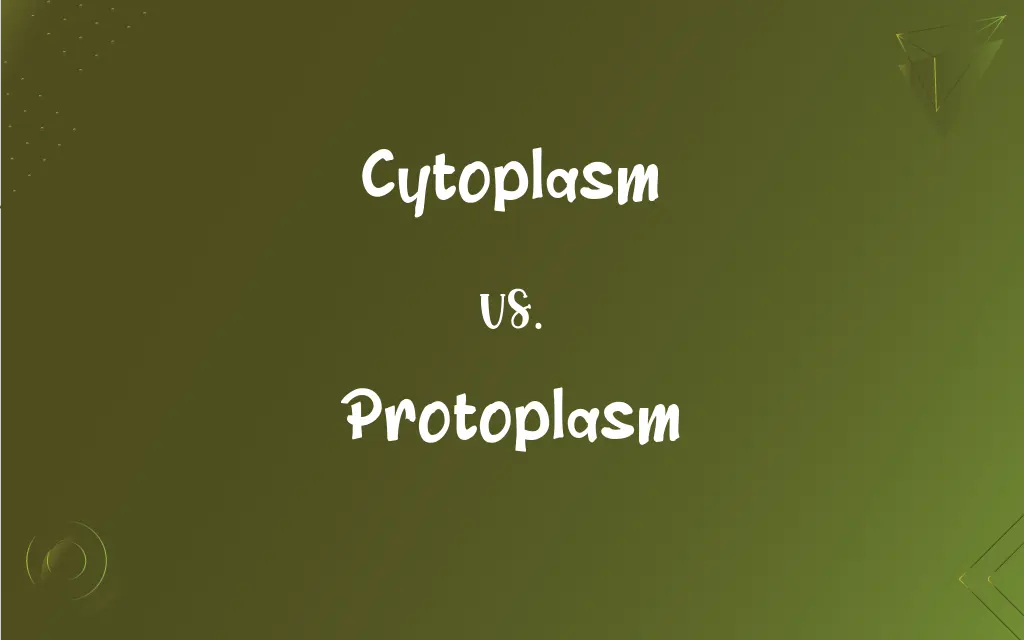Cytoplasm vs. Protoplasm: What's the Difference?
Edited by Janet White || By Harlon Moss || Updated on October 10, 2023
Cytoplasm is the fluid within cells excluding the nucleus, while protoplasm includes both cytoplasm and the nucleus.

Key Differences
Cytoplasm and protoplasm are fundamental components of a cell, each encompassing distinct structures and performing specific functions that contribute to cellular life and activity. Cytoplasm refers to the semi-fluid substance within a cell, excluding the nucleus, where it provides a medium for organelles and other cellular structures, facilitating metabolic activities and transport within the cell. Protoplasm, on the other hand, includes all the living parts of the cell: the cytoplasm and the nucleus, often considered the physical basis of life, and provides the essential components and environment for the cell’s metabolic processes, illustrating their integral and encompassing roles in cellular function and life.
The historical and terminological usage of the words cytoplasm and protoplasm reveals the evolution of our understanding of cellular biology and structures. Protoplasm, being one of the earliest terms used to describe the living substance within cells, was historically viewed as the fundamental material of life, providing the structural and functional basis for cellular activity. Cytoplasm, as a term, emerged later, providing a more specific and differentiated understanding of the cell's internal environment by particularly referring to the cellular contents outside the nucleus, signifying the evolution and refinement of cellular biology concepts over time.
In considering cellular organization and structure, the distinctions between cytoplasm and protoplasm become particularly pronounced, with each term encompassing different aspects of cellular life and complexity. The cytoplasm consists of all of the cellular material, organelles, and structures outside the nucleus, acting as a site for many cellular processes, including glycolysis and the synthesis of proteins on ribosomes. Protoplasm, comprising both the cytoplasm and nucleus, encapsulates the entirety of the cell's living content, thus encompassing all structures and components that execute the cellular functions and genetic instructions, underlining the hierarchical and spatial differentiation between these terms.
In analyzing the functional implications of cytoplasm and protoplasm, each emerges as vital for various cellular activities, yet they are functionally distinct due to the structures and processes they encompass. Cytoplasm acts as a medium that facilitates the movement of cellular materials and the execution of metabolic reactions, providing both a physical and functional context for numerous cellular processes. Protoplasm, by encompassing all living cellular components, reflects the entirety of the cellular operational and functional framework, implying a broader and more holistic perspective of cellular functioning, which involves both the activities occurring within the cytoplasm and the genetic information processing within the nucleus.
From an educational and scientific communication perspective, the nuanced understanding of cytoplasm and protoplasm serves as a critical factor in conveying cellular biology concepts effectively. Educators and communicators use the term cytoplasm to denote the site of numerous cellular activities and the location of various organelles, providing a specific and localized understanding of intracellular processes and structures. The term protoplasm, while perhaps less commonly used in contemporary cellular biology, provides a holistic term that encompasses the entire living content of a cell, facilitating discussions and understandings that consider the integrated and collective functionalities of both the nucleus and cytoplasm, revealing their interconnected and systemic nature in the life of a cell.
ADVERTISEMENT
Comparison Chart
Definition
Gel-like substance inside cell membrane excluding the nucleus
Entire living content of a cell, including cytoplasm and nucleus
Constituents
Organelles, enzymes, and soluble molecules
Nucleus, organelles, and cytoplasm
Role
Supports cellular processes and maintains cell shape
Holds all vital components for cell's life functions
Relation to Cell
Part of the cell's interior
Represents the cell's entire living content
Context
Used when referring to cell contents excluding the nucleus
Used to describe all living components of a cell
ADVERTISEMENT
Cytoplasm and Protoplasm Definitions
Cytoplasm
The gel-like matrix inside a cell excluding the nucleus.
The cytoplasm contains various organelles that perform cellular functions.
Protoplasm
The entire living content within a cell.
Protoplasm encompasses all the vital elements necessary for cell life.
Cytoplasm
Cellular content outside the nucleus but within the cell membrane.
Molecular transport occurs within the cytoplasm.
Protoplasm
Often referred to as the "physical basis of life."
Life processes occur within the protoplasm, making it fundamental to life.
Cytoplasm
Facilitates movement and expansion of cells.
The fluid nature of the cytoplasm allows cells to change shape.
Protoplasm
A collective term for the vital parts of a cell.
The protoplasm contains everything essential for cellular functions.
Cytoplasm
The site of many metabolic processes.
The cytoplasm is bustling with metabolic activity and reactions.
Protoplasm
Includes both the cytoplasm and the cell nucleus.
The cell's genetic information is housed within the nucleus, which is part of the protoplasm.
Cytoplasm
Provides a medium for cellular organelles.
Organelles float and operate within the supportive medium of the cytoplasm.
Protoplasm
A term describing the living material of cells.
Scientists study protoplasm to understand cellular activities.
Cytoplasm
The protoplasm enclosed by the plasma membrane of cell, excluding the nucleus in eukaryotic cells and cellular DNA in prokaryotic cells.
Protoplasm
The complex, semifluid, translucent substance that constitutes the interior matter of a living cell and is composed of proteins, fats, and other molecules suspended in water. It includes the cytoplasm, the nucleus in eukaryotes, and organelles such as mitochondria.
Cytoplasm
(cytology) The contents of a cell except for the nucleus. It includes cytosol, organelles, vesicles, and the cytoskeleton.
Protoplasm
(cytology) The entire contents of a cell comprising the nucleus and the cytoplasm. It is a semi-fluid, transparent substance which is the living matter of plant and animal cells.
Cytoplasm
The substance of the body of a cell, as distinguished from the karyoplasma, or substance of the nucleus.
Protoplasm
The viscid and more or less granular material of vegetable and animal cells, possessed of vital properties by which the processes of nutrition, secretion, and growth go forward; the so-called " physical basis of life;" the original cell substance, cytoplasm, cytoblastema, bioplasm sarcode, etc.
Cytoplasm
The protoplasm of a cell excluding the nucleus
Protoplasm
The living substance of a cell (including cytoplasm and nucleus)
FAQs
What is cytoplasm primarily composed of?
Cytoplasm is primarily composed of water, salts, and proteins.
Where are cellular organelles located?
Organelles are located in the cytoplasm.
What role does cytoplasm play in cell shape?
Cytoplasm provides a supportive medium that helps maintain cell shape.
Which term represents all living cell contents?
Protoplasm represents all living contents of a cell.
Does protoplasm include cell walls in plants?
No, protoplasm refers to the living content inside the cell wall.
What distinguishes cytoplasm from protoplasm in a cell's context?
Cytoplasm excludes the nucleus, while protoplasm includes both cytoplasm and nucleus.
How does the cytoplasm interact with the nucleus?
The cytoplasm surrounds the nucleus and facilitates exchange of materials with it.
How are metabolic reactions facilitated in a cell?
Most metabolic reactions occur in the cytoplasm.
Why is protoplasm often referred to as the "basis of life"?
Because protoplasm contains all vital components and functions essential for cell life.
How does the cytoplasm aid in cellular defense?
The cytoplasm contains organelles like lysosomes that help in cellular defense.
How critical is the role of protoplasm in cell survival?
Protoplasm is essential; without it, cells wouldn't have the necessary components to live and function.
What does protoplasm encompass in a cell?
Protoplasm encompasses both the cytoplasm and the nucleus.
Is the nucleus part of the protoplasm?
Yes, the nucleus is an integral component of the protoplasm.
What is the significance of cytoplasm in cellular transport?
Cytoplasm facilitates molecular movement and distribution within the cell.
What would you find in the cytoplasm?
You would find organelles, enzymes, and soluble molecules in the cytoplasm.
Does cytoplasm have a set structure?
No, cytoplasm is gel-like and lacks a rigid structure.
Is the cell membrane part of the protoplasm?
No, the protoplasm refers to the content inside the cell membrane.
Which term, cytoplasm or protoplasm, is broader in context?
Protoplasm is broader, encompassing the entire living content of a cell.
Are cell organelles part of the protoplasm?
Yes, cell organelles, present in the cytoplasm, are part of the protoplasm.
Do all cells have cytoplasm and protoplasm?
Yes, all cells have cytoplasm, and by extension, protoplasm, as they contain the living material of the cell.
About Author
Written by
Harlon MossHarlon is a seasoned quality moderator and accomplished content writer for Difference Wiki. An alumnus of the prestigious University of California, he earned his degree in Computer Science. Leveraging his academic background, Harlon brings a meticulous and informed perspective to his work, ensuring content accuracy and excellence.
Edited by
Janet WhiteJanet White has been an esteemed writer and blogger for Difference Wiki. Holding a Master's degree in Science and Medical Journalism from the prestigious Boston University, she has consistently demonstrated her expertise and passion for her field. When she's not immersed in her work, Janet relishes her time exercising, delving into a good book, and cherishing moments with friends and family.































































